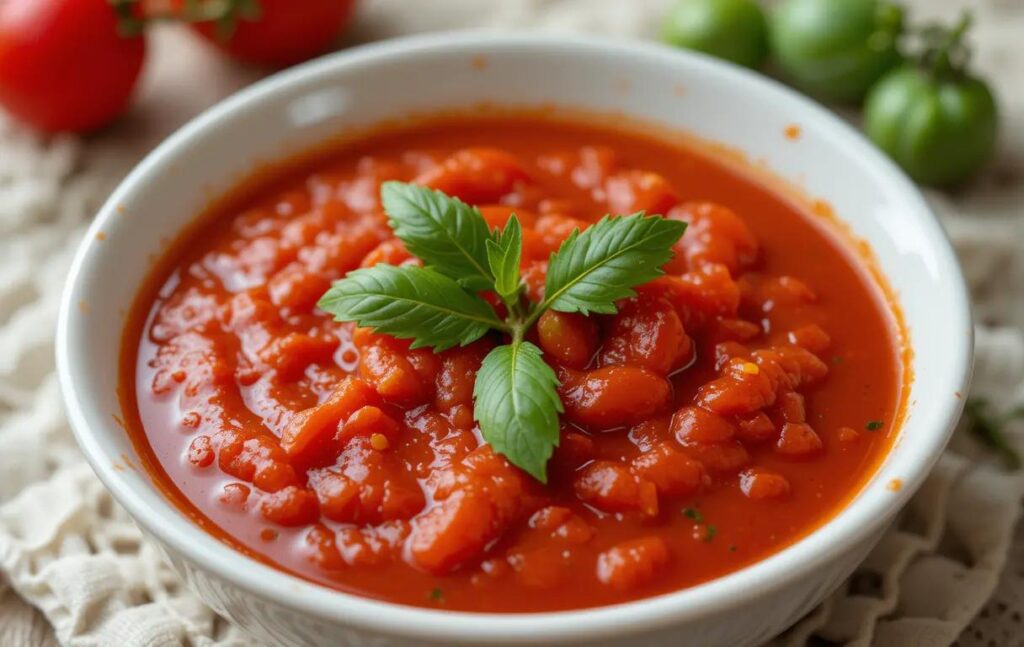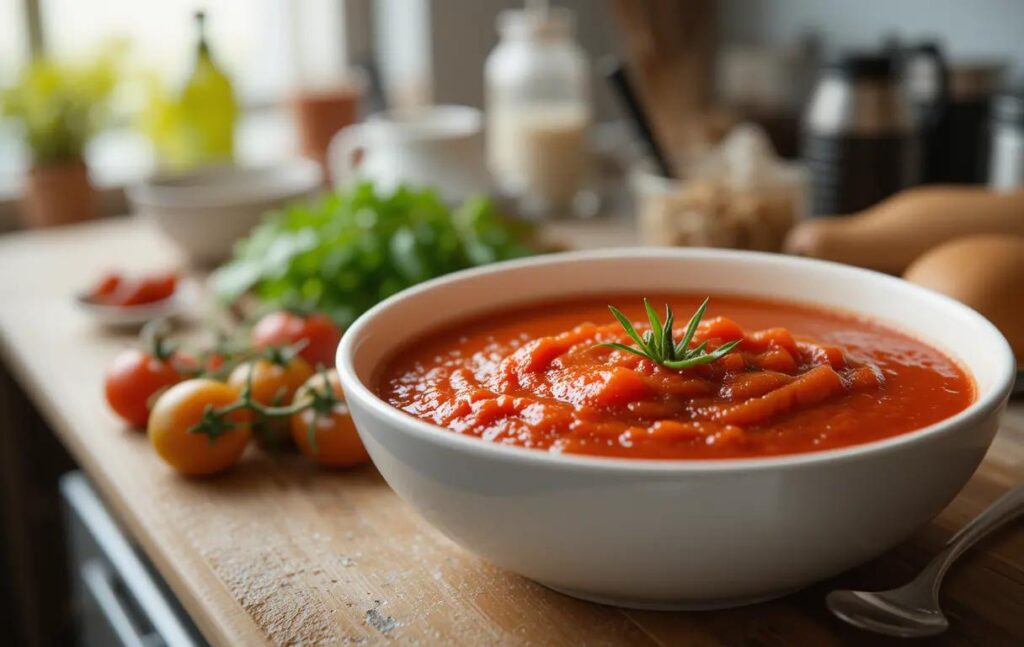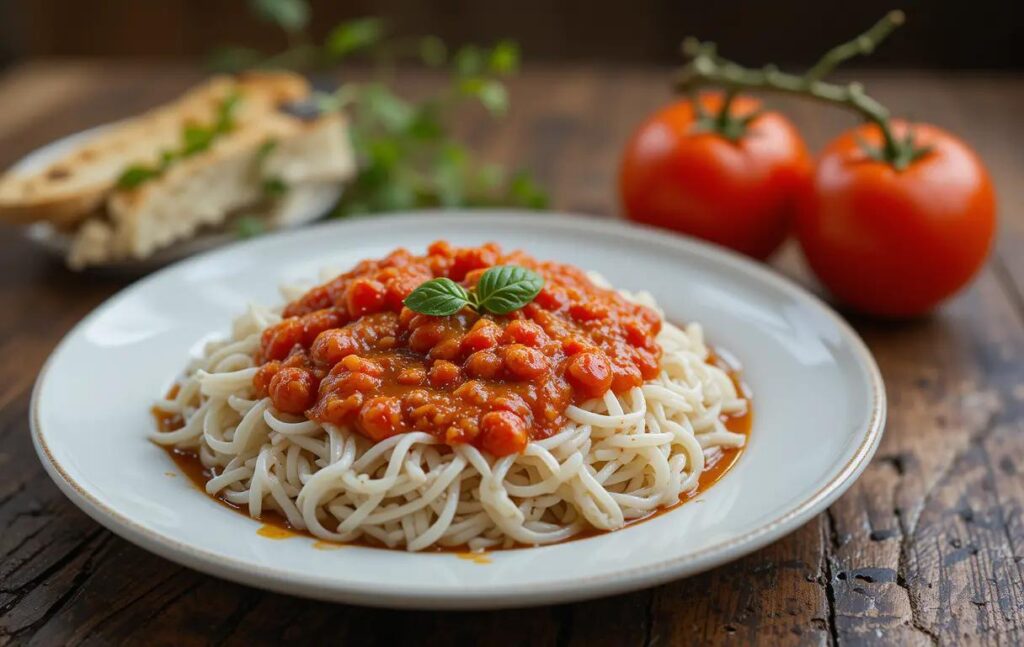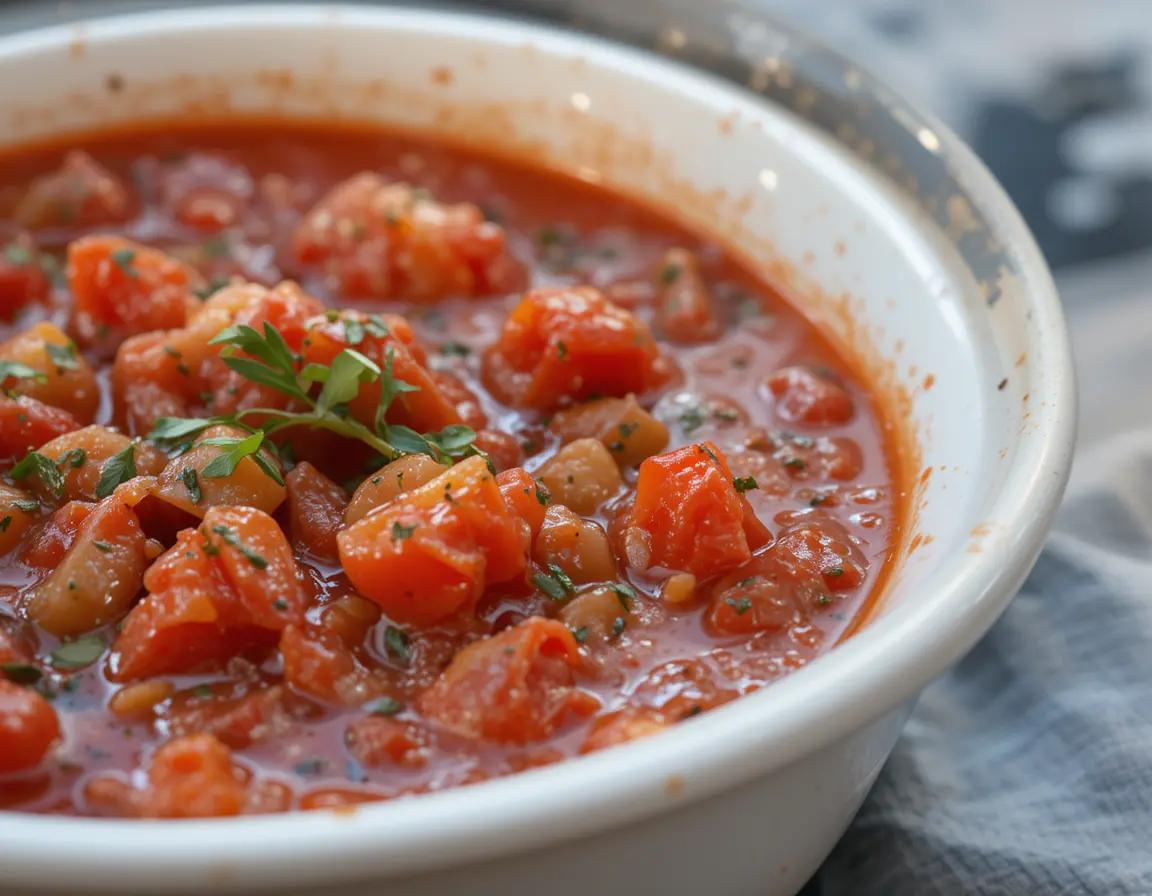What is Tomato Gravy Made Of?
Tomato gravy is a beloved dish in many culinary traditions, combining the rich tanginess of tomatoes with savory spices and herbs. Often used as a versatile sauce, it pairs beautifully with a variety of foods like rice, bread, or even pasta. But what is tomato gravy made of? The answer lies in a simple yet flavorful combination of fresh ingredients that can be tailored to suit any palate.
At its core, Tomato Sauce typically includes ripe tomatoes, onions, garlic, and a choice of cooking oil or butter. However, regional and personal variations often incorporate unique twists, making each recipe truly special. Whether you prefer a creamy Southern-style version or a spicy Indian-inspired one, tomato gravy’s appeal lies in its adaptability and depth of flavor.
The Basic Ingredients of Tomato Gravy
Tomato gravy is a simple yet versatile dish with a base of ingredients that form the foundation of its rich and savory flavor. Let’s explore these essential components and what makes them so integral to the dish.
1. Tomatoes: The Star Ingredient
Tomatoes are the heart of Tomato Sauce. They provide the tangy, slightly sweet base that defines the dish. Both fresh and canned tomatoes work well, depending on preference:
- Fresh Tomatoes: Use ripe, red tomatoes for a natural, robust flavor. Plum or Roma tomatoes are especially popular for their lower water content and richer taste.
- Canned Tomatoes: Ideal for convenience, canned tomatoes like crushed or diced varieties add consistent texture and flavor. Look for ones with no added preservatives for a purer taste.
2. Onions: The Flavor Enhancer
Onions add a subtle sweetness and depth to Tomato Sauce. Depending on the recipe, you may use:
- Yellow Onions: Best for a mild and sweet flavor.
- Red Onions: Provide a slightly sharper taste and vibrant color.
- White Onions: Ideal for a cleaner, more delicate onion note.
Onions are usually sautéed in oil or butter until translucent to bring out their natural sweetness.
3. Garlic: The Aromatic Boost
No Tomato Sauce is complete without garlic. It adds a warm, pungent aroma that complements the acidity of tomatoes. Freshly minced garlic is preferred for its bold flavor, but garlic powder can work in a pinch.
4. Fat: The Cooking Base
A choice of cooking fat is essential to sauté the onions and garlic, and to create a rich texture:
- Olive Oil: A healthier, Mediterranean-inspired option.
- Butter: Adds creaminess and a slightly nutty flavor, common in Southern-style tomato gravy.
- Ghee: Often used in Indian variations for its deep, caramelized taste.
5. Broth or Stock
Adding a splash of chicken, vegetable, or beef stock enhances the gravy’s richness and helps balance the tomato’s acidity. For a vegetarian option, a well-flavored vegetable broth works perfectly.
6. Seasonings: The Perfect Blend
Seasonings tie all the ingredients together. Common ones include:
- Salt and Pepper: To enhance and balance flavors.
- Sugar: Just a pinch helps reduce acidity and add balance to the tomatoes.
- Red Pepper Flakes: For those who love a bit of heat.
7. Optional Thickeners
Some recipes include a thickening agent to create a creamier consistency:
- Flour: A classic choice, often used in Southern recipes to create a roux with butter.
- Cornstarch: A gluten-free alternative for a silky texture.
- Cream: Adds richness and smoothness, transforming it into a luxurious sauce.
These ingredients form the backbone of Tomato Sauce. While simple on their own, they combine to create a flavorful dish that can be tailored with endless variations.
Variations in Tomato Gravy Recipes

Tomato gravy’s appeal lies in its adaptability, with countless variations based on cultural, regional, and personal preferences. Let’s dive into the most popular styles and the unique ingredients that make each one special.
1. Southern-Style Tomato Gravy
Southern tomato gravy is a beloved comfort food often served with biscuits, grits, or fried chicken. This version is rich, creamy, and slightly tangy. Key ingredients include:
- Milk or Cream: Added to the base for a velvety texture.
- Flour Roux: A roux made from butter and flour is used to thicken the gravy.
- Bacon Drippings: Many Southern recipes use bacon grease for added smokiness and depth.
Pro Tip: Southern Tomato Sauce often incorporates a pinch of cayenne pepper or hot sauce for a subtle kick.
2. Indian-Style Tomato Gravy
In Indian cuisine, Tomato Sauce forms the foundation for many curries and stews. It is aromatic, spicy, and intensely flavorful. Unique additions include:
- Spices: Garam masala, cumin, turmeric, and coriander create a complex flavor profile.
- Ginger and Green Chilies: Used alongside garlic for added heat and aroma.
- Yogurt or Coconut Milk: These ingredients balance the spices and add a creamy consistency.
This variation is often paired with naan, rice, or lentils.
3. Italian-Style Tomato Sauce
Though similar to tomato gravy, Italian-style Tomato Sauce emphasizes simplicity and fresh flavors. It’s used as a base for pasta, pizza, and more. Typical ingredients include:
- Fresh Basil and Oregano: Herbs that highlight the sweetness of tomatoes.
- Extra Virgin Olive Oil: Adds a fruity richness to the sauce.
- Red Wine: A splash of wine deepens the flavor profile.
4. Vegan Tomato Gravy
For plant-based eaters, vegan Tomato Sauce offers a dairy-free alternative that doesn’t compromise on flavor. Key substitutions include:
- Plant-Based Milk: Almond or cashew milk adds creaminess without dairy.
- Nutritional Yeast: Provides a slightly cheesy flavor.
- Vegetable Stock: Used instead of meat-based broths.
This version is perfect for pairing with roasted vegetables or grain dishes.
5. Meaty Tomato Gravy
Meaty variations of tomato gravy incorporate protein for a heartier dish. Common choices include:
- Ground Beef or Pork: Simmered in the gravy to create a ragu-like consistency.
- Sausage or Meatballs: Often served with pasta or polenta.
- Seafood: Shrimp or crab can be added for a coastal twist.
6. Spicy Tomato Gravy
For those who love bold flavors, spicy Tomato Sauce delivers heat and intensity. Ingredients to amp up the spice include:
- Chili Powder or Paprika: Adds smokiness and warmth.
- Hot Sauce: A few dashes of Tabasco or Sriracha can elevate the dish.
- Fresh Chili Peppers: Jalapeños or habaneros bring fresh heat.
How to Customize Your Tomato Gravy
One of the best things about tomato gravy is its versatility. You can mix and match ingredients to create your perfect version. Consider these additions:
- Vegetables: Bell peppers, zucchini, or mushrooms.
- Cheese: Parmesan or cheddar for a richer taste.
- Fresh Herbs: Cilantro, thyme, or parsley to brighten the flavors.
By exploring these variations, you can find a Tomato Sauce recipe that suits your taste or experiment to create your own unique version.
How to Make Tomato Gravy – A Step-by-Step Guide

Crafting a delicious tomato gravy is simple, but the method can vary slightly based on your chosen style. Below is a general guide for a classic tomato gravy recipe, along with tips to customize it to your taste.
Ingredients You’ll Need
- 3 cups tomatoes: Fresh, diced, or canned (crushed or diced).
- 1 medium onion: Finely chopped.
- 3 cloves garlic: Minced.
- 2 tbsp cooking oil or butter: Olive oil for a lighter flavor or butter for richness.
- 1 cup broth or stock: Vegetable, chicken, or beef stock, depending on your preference.
- 1 tbsp flour or cornstarch: For thickening (optional).
- Seasonings:
- 1 tsp salt
- ½ tsp black pepper
- 1 tsp sugar (to balance acidity)
- Optional: chili flakes, paprika, or herbs like basil or oregano.
Step 1: Prep Your Ingredients
Before cooking, ensure all your ingredients are chopped, minced, and measured. This will streamline the process.
Pro Tip: If using fresh tomatoes, you can peel them for a smoother consistency. To do this, blanch them in boiling water for 30 seconds, then transfer them to an ice bath. The skins will slip right off.
Step 2: Sauté Onions and Garlic
- Heat the oil or butter in a large skillet over medium heat.
- Add the chopped onions and sauté until translucent, about 3–4 minutes.
- Stir in the minced garlic and cook for another minute until fragrant.
Tip: Avoid browning the garlic as it can turn bitter.
Step 3: Add the Tomatoes
- Stir in the diced or canned tomatoes. If using fresh tomatoes, mash them slightly to release their juices.
- Let the mixture simmer for 8–10 minutes, stirring occasionally. This allows the tomatoes to break down and blend with the onions and garlic.
Optional: If you prefer a smooth gravy, use an immersion blender at this stage to puree the mixture.
Step 4: Add Broth and Seasonings
- Pour in the broth or stock, stirring well to combine.
- Add salt, pepper, sugar, and any additional spices or herbs you’d like.
- Simmer the gravy for another 10 minutes, allowing the flavors to meld and the sauce to thicken.
Tip: If the gravy is too thin, mix 1 tbsp flour or cornstarch with 2 tbsp water to create a slurry, then stir it into the gravy.
Step 5: Taste and Adjust
- Taste your tomato gravy and adjust the seasonings as needed. Add a pinch of sugar if the tomatoes are too acidic or a splash of cream for extra richness.
- If you’re making a specific variation (e.g., Southern-style), incorporate ingredients like milk or bacon drippings at this stage.
Step 6: Serve Your Tomato Gravy
Tomato gravy is incredibly versatile and pairs well with various dishes. Here are a few serving suggestions:
- Over warm biscuits or grits for a Southern-inspired breakfast.
- As a topping for mashed potatoes or rice.
- With pasta, polenta, or roasted vegetables.
Tips for Perfect Tomato Gravy
- Low and Slow: Cooking over low heat ensures the flavors develop fully without burning.
- Fresh Herbs Last: If using fresh herbs like basil or parsley, add them just before serving to retain their bright flavor.
- Storage: Leftover Tomato Sauce can be stored in an airtight container in the refrigerator for up to 5 days or frozen for 3 months.
Serving Suggestions and Health Benefits of Tomato Gravy

Tomato gravy is not just flavorful; it’s also incredibly versatile and nutritious. This section explores the best ways to serve Tomato Sauce and highlights its health benefits.
Serving Suggestions
Tomato gravy shines when paired with a variety of dishes. Here are some of the most popular ways to enjoy it:
Classic Southern Pairings
- Biscuits: A warm biscuit topped with creamy Southern-style Tomato Sauce makes for a comforting breakfast or brunch.
- Grits: Serve tomato gravy over creamy grits for a hearty meal. Adding a poached egg or shrimp elevates it even further.
- Fried Chicken: Use Tomato Sauce as a dipping sauce or a drizzle over crispy fried chicken.
Global Inspirations
- Pasta: Italian-style tomato gravy serves as a rich base for spaghetti or fettuccine. Add meatballs or grated Parmesan for a traditional touch.
- Rice Dishes: In Indian cuisine, Tomato Sauce is often paired with basmati rice, complemented by lentils or spiced meat.
- Polenta: A ladle of tomato gravy over creamy polenta creates a delicious and comforting dish.
Vegetarian Options
- Roasted Vegetables: Drizzle Tomato Sauce over roasted zucchini, bell peppers, or eggplant for a light and flavorful meal.
- Stuffed Bell Peppers: Use tomato gravy as a sauce for baked stuffed peppers, filled with quinoa, beans, or cheese.
Creative Twists
- Pizza Sauce: Spread a thicker tomato gravy on pizza dough as a flavorful base for your favorite toppings.
- Casseroles: Layer tomato gravy into lasagna or other baked dishes for added richness.
- Dips: Reduce tomato gravy slightly to create a thicker consistency, perfect for dipping crusty bread or crackers.
Health Benefits of Tomato Gravy
Tomato gravy is not just delicious—it’s also packed with nutrients, making it a healthy addition to your meals. Here’s a closer look at its key benefits:
Rich in Vitamins and Minerals
- Vitamin C: Tomatoes are a great source of vitamin C, which supports the immune system and skin health.
- Vitamin A: Promotes good vision and supports the immune system.
- Potassium: Helps regulate blood pressure and maintain proper muscle function.
High in Antioxidants
Tomatoes are rich in lycopene, a powerful antioxidant that has been linked to reduced risks of heart disease and certain types of cancer. Cooking tomatoes increases the bioavailability of lycopene, making tomato gravy especially beneficial.
Low in Calories
Tomato gravy is naturally low in calories, making it a great choice for those watching their weight. Use olive oil and limit added sugars for a healthier version.
Heart-Healthy Fats
If prepared with olive oil, Tomato Sauce provides monounsaturated fats, which are beneficial for heart health.
Customizable for Dietary Needs
- Vegetarian and Vegan: Use vegetable stock and plant-based milk for a vegan-friendly option.
- Gluten-Free: Substitute flour with cornstarch or arrowroot powder for thickening.
- Low-Sodium: Opt for no-salt-added tomatoes and reduce added salt for a heart-healthy version.
Nutritional Profile (Approximate Per Serving)
- Calories: 90 (based on a basic recipe)
- Protein: 2g
- Carbohydrates: 8g
- Fat: 6g
- Fiber: 2g
- Vitamin C: 25% of daily value
Tomato gravy combines flavor and nutrition, making it an excellent choice for any meal. Whether you serve it over biscuits, pasta, or vegetables, it’s sure to satisfy.
Frequently Asked Questions about Tomato Gravy
Q1: Can I make tomato gravy in advance?
Yes, tomato gravy can be made ahead of time and stored in the refrigerator for up to 5 days. Simply reheat it on the stovetop, adding a splash of water or broth if it thickens too much.
Q2: Can I freeze tomato gravy?
Absolutely! Tomato gravy freezes well for up to 3 months. Use an airtight container or freezer-safe bag, and thaw it in the refrigerator overnight before reheating.
Q3: Can I use canned tomatoes instead of fresh ones?
Yes, canned tomatoes work wonderfully in tomato gravy. Choose high-quality options like whole peeled, diced, or crushed tomatoes for a consistent texture and flavor.
Q4: How do I fix tomato gravy that’s too sour?
If your gravy tastes too sour, add a pinch of sugar to balance the acidity. Alternatively, stirring in a bit of cream or butter can also mellow out the tanginess.
Q5: Is tomato gravy gluten-free?
It can be! Simply replace flour with cornstarch or another gluten-free thickener. Many recipes naturally omit flour, making them suitable for gluten-free diets.
Q6: What’s the difference between tomato gravy and tomato sauce?
While both are tomato-based, tomato gravy typically has a richer, thicker consistency and includes a roux or cream in some variations. It’s often paired with biscuits or Southern dishes, whereas tomato sauce is more commonly used for pasta or pizza.
Conclusion
Tomato gravy is a versatile, flavorful dish that’s beloved in kitchens around the world. Whether you enjoy it creamy and comforting over biscuits, spicy and aromatic with rice, or hearty with added proteins, the possibilities are endless.
At its core, the answer to “What is tomato gravy made of?” lies in the combination of fresh tomatoes, onions, garlic, and seasonings, with countless ways to customize and adapt it to your taste. Its nutritional benefits and ease of preparation make it a must-try for anyone looking to elevate their meals.
So why not try making tomato gravy at home? Experiment with the ingredients, explore new variations, and discover how this humble yet delicious dish can transform your cooking.
Mama’s Tomato Gravy
Related Recipes
- “Tuna Tomato Sauce Pasta Recipe“: A tomato-based recipe showcasing another way to use tomatoes.
- “Baked Chicken Fettuccine Alfredo with Broccoli“: Another comforting dish that can be complemented with tomato-based sauces.
Ingredient-Focused Content
- “Lions Mane Mushroom Recipe“: Suggest using a tomato gravy as a flavorful addition for plant-based dishes.
Cooking Techniques and Enhancements
- “Mango Habanero Salsa“: Explore complementary uses of sauces and gravies for flavor diversity.
Storage and Reuse Tips
- “Sous Vide Recipes“: Recommend tomato gravy as a sauce for sous vide-cooked meats or vegetables.
- “Ocean Spray Cranberry Sauce Recipe“: Guide readers on making and storing sauces, including tomato gravy.

